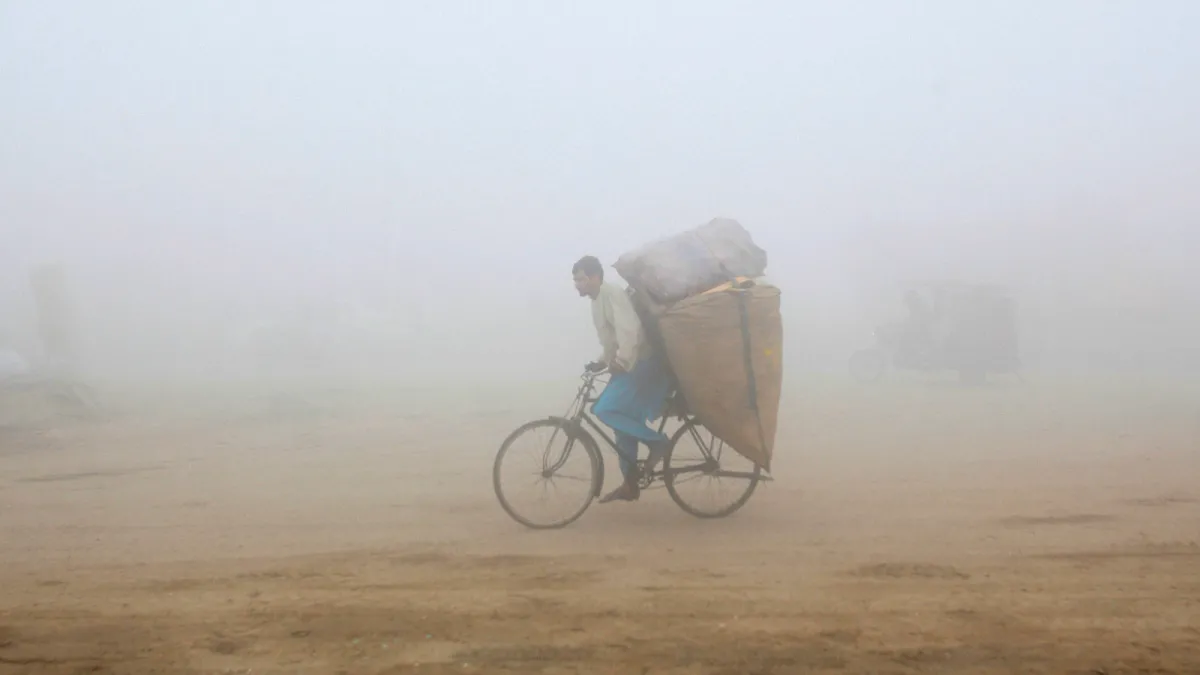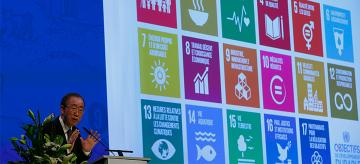How Climate Change Affects Our Health
A warmer world threatens more extreme weather and infectious disease, but policymakers can counter climate change’s damages to global health.
The World Health Organization (WHO) calls climate change “the single biggest health threat facing humanity.”
Extreme weather events like hurricanes, heat waves, and droughts can all have direct health consequences. Those include heat stroke, injuries from floods and failing infrastructure, malnutrition, and dehydration. But climate change has subtler and more gradual effects too. Higher temperatures stress our bodies in ways they weren’t designed for. Air pollution causes higher rates of heart and lung disease. Warming temperatures will allow infectious diseases to spread faster and further.
This resource explores the ways climate change threatens human health and some strategies people can adopt to protect themselves.
Extreme weather
As climate change makes extreme weather events more frequent and severe, the dangers they pose increase too.
Floods, fires, high winds, and the destruction of buildings can all directly harm or kill people. But disasters also have less visible consequences for human health. Disasters can damage or block access to health-care infrastructure, making treating patients more difficult. They can also release harmful pollutants and pathogens. Flooding from heavy rainfall, for instance, can cause toxic mold to grow in homes or increase the spread of some waterborne disease. On top of those physical factors, extreme weather events cause immense psychological stress that can exacerbate other health issues over time.
Through those indirect factors, such events can cause much more damage than initial reports can capture. When Hurricane Maria hit Puerto Rico in 2017, for example, official reports stated that the storm killed sixty-four people. But researchers later estimated the actual death toll to be nearly three thousand. One study estimates that the average hurricane and tropical storm in the United States leads to between seven thousand and fifteen thousand excess deaths in the fifteen years following the storm.
Heat
The human body is designed to maintain an internal temperature of about 98.6°F. In hot weather, the body can cool itself by sweating. But if it’s too hot, the body has trouble maintaining its regular temperature, which can cause dizziness and confusion. Extreme body temperatures—about 106°F—cause the body to start physically breaking down, leading to seizures, organ failure, and death.
More people are now being exposed to extreme heat. In 2023, 6.8 billion people— more than three-quarters of the world—experienced at least thirty-one days of extreme heat. Often, countries are not prepared for those conditions. The United Kingdom, for example, has historically enjoyed a cool climate, so most homes lack air conditioning. That fact proved deadly when heat waves in the summer of 2022 sent temperatures soaring, causing nearly three thousand heat-related deaths.
Heat is especially dangerous for certain vulnerable groups. It is more difficult, for instance, for infants, toddlers, and the elderly to regulate their body temperatures. People suffering from certain chronic health conditions, including heart disease and diabetes, are also more vulnerable to heat stress. And working outdoors in physically taxing jobs, such as farming or construction, generates heat on its own, making the body work harder to cool down.
More countries can expect to see extreme heat in the future. For dozens of them, if current emissions trends continue, temperatures over 95°F will last weeks or months longer than they did at the end of the twentieth century. Some countries, particularly those in the Middle East and West Africa, could spend most of the year with temperatures that high.
Air quality
The WHO estimates that air pollution is responsible for seven million premature deaths every year, mainly from heart and lung diseases. That makes air pollution one of the world’s leading killers, behind only high blood pressure, smoking, and diabetes.
Most pollution comes from burning fossil fuels, which leaves behind small particles of soot and other waste. Breathing those pollutants can inflame airways, making breathing more difficult and aggravating existing lung conditions. The smallest particles can penetrate the bloodstream, which can raise blood pressure and increase the risk of heart diseases and cancer.
Climate change itself is also projected to worsen air pollution in the coming decades. Some gases released by fossil fuel combustion react in the atmosphere to form ozone, and higher temperatures make it easier for ozone to form. When it’s high in the atmosphere, a layer of ozone helps filter dangerous radiation from the sun. But when it is near the ground, ozone can irritate the lungs, causing serious health problems, even for healthy people, and potentially deadly ones for those with existing lung conditions.
Prolonged heat waves can also worsen other forms of air pollution, particularly through more frequent and severe wildfires. One study found that wildfire smoke in the United States contributes to more than eleven thousand deaths annually. It has also been linked to other health conditions, such as dementia. Climate change is increasing and worsening wildfires, meaning those numbers could continue to rise.
Disease
Experts view climate change as a threat multiplier for infectious disease. Organizations like the WHO and the Centers for Disease Control and Prevention (CDC) anticipate more frequent outbreaks of infectious diseases. How? Climate change can influence such diseases in several ways.
Increased contact with animals: Climate change, alongside activities like deforestation and land development, is bringing human populations into closer proximity with animals. That makes it easier for zoonotic diseases to jump from animals to humans, increasing the frequency and severity of infectious disease outbreaks. In many areas, for example, mosquitoes now thrive in areas that were previously too cool for them—including on Mount Everest. So, they’ve been able to transmit diseases like dengue fever to more people.
New (and old) diseases: Scientists have warned that melting permafrost in the Arctic could release ancient viruses. Infectious diseases—sometimes called zombie viruses—have been locked under Arctic Sea ice for tens of thousands of years. As Arctic ice melts, increased shipping, mining, and oil drilling are expected to raise the risks of diseases spreading. In 2016, for example, northern Russia experienced a rare anthrax outbreak that originated from a long-frozen reindeer carcass.
Sanitation struggles: Climate change will make waterborne diseases like typhoid and cholera more common. Warmer temperatures make it easier for bacteria to survive and reproduce. Droughts can concentrate contaminants in water sources while also increasing demand for water. And heavy rainfall and flooding [PDF] can overwhelm water and waste management infrastructure, contaminating water sources and making it difficult to reestablish a safe supply.
Foodborne illnesses like salmonella, listeria, and E. coli will also become more common. Climate change will enable the pathogens that cause those diseases to spread to new areas, survive for more of the year, and reproduce more successfully. Warmer temperatures also make it more difficult to safely store food, especially in areas without reliable access to refrigeration or electricity.
What can countries do about climate change’s health threats?
Clearly, climate change and global health challenges are closely interlinked. That means many climate and health solutions are interlinked too. Mitigating climate change will help lessen its harm to human health, as will taking adaptation and resilience measures. For example, resilient infrastructure that prepares communities for high temperatures will ease some of the health hazards that come with extreme heat. But humans can adapt the world’s public health systems in several specific ways to better deal with climate change.
Investments in resilient health infrastructure can make communities better able to deal with extreme weather events. For example, in small island countries in the Caribbean, the WHO has introduced a “smart hospitals”[PDF] initiative to construct more resilient and sustainable hospitals that can better withstand storms. Improved weather forecasting techniques and public communication can also help health-care systems ensure they are ready to treat an influx of patients and allow communities more time to prepare for severe weather or evacuate if necessary.
To help ease the effects of extreme heat, communities can construct cooling centers. Those can be especially crucial for communities without widespread access to home air conditioning. Early warning and public messaging play a role in adapting to extreme heat as well. When temperatures rise to dangerous levels, local governments can inform residents to spend less time outdoors, conserve electricity to avoid power outages, or seek out cooling centers nearby.
Governments can implement adaptations targeting infectious diseases as well. They can monitor infectious diseases more closely, especially as new threats emerge or expand to new areas. For example, the U.S. Agency for International Development (USAID) trains health officials in Vietnam to improve and manage databases to track the spread of illnesses.
Governments and health organizations can also prevent infectious disease threats. Regulations on water pollution, for example, can lower the health risks of waterborne diseases. In other cases, vaccination campaigns can help slow the expansion of some diseases, such as dengue fever. When outbreaks do occur, governments can ensure that communities have the supplies necessary to manage them. Especially as climate change is causing some diseases to expand in range, this means equipping health-care systems with supplies they previously did not need. Improved outbreak response also includes funding research and development and implementation of effective vaccines.
The adaptations required to address climate-related health threats will involve governments at the local, regional, and national levels. Moreover, like climate change, health threats know no borders. A Lyme-disease-carrying tick in the northeastern United States does not care if it crosses into Canada. So international organizations can take the lead in coordinating effective strategies among countries.
Climate change poses an unprecedented threat to human health. Governments and other organizations are increasingly aware of the need to consider climate change as a part of any global health strategy. Addressing its dangers, in addition to improving health systems generally, will play an important part in protecting human health and safety.








